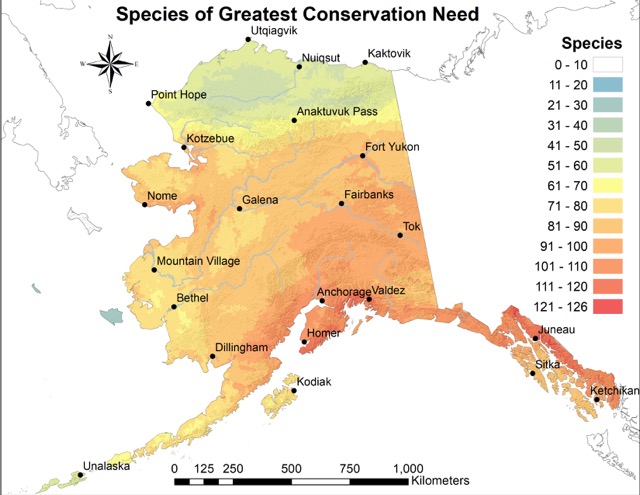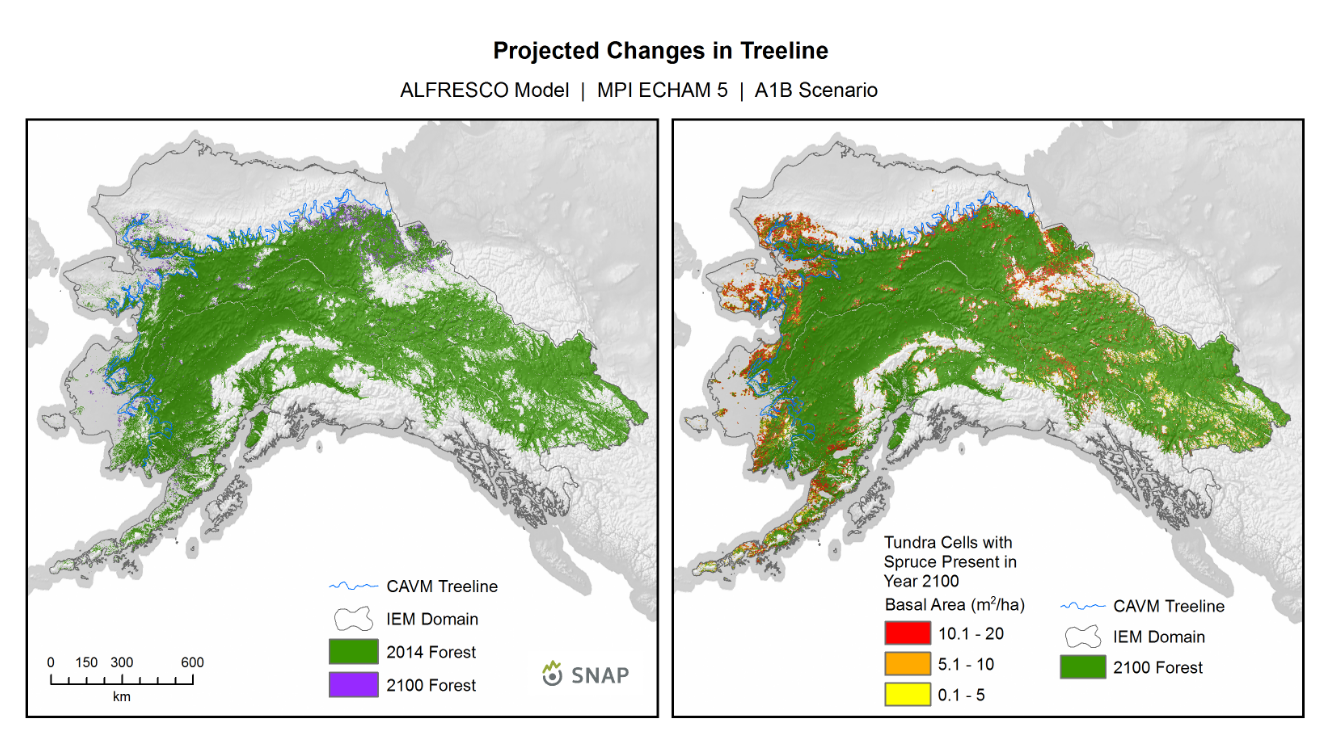biota
Type of resources
Topics
Keywords
Contact for the resource
Provided by
Years
Formats
Representation types
Update frequencies
status
Resolution
-

This 1km land cover dataset represent highly modified output originating from the Alaska portion of the North American Land Change Monitoring System (NALCMS) 2005 dataset as well as the National Land Cover Dataset 2001. This model input dataset was developed solely for use in the ALFRESCO, TEM, GIPL and the combined Integrated Ecosystem Model landscape scale modeling studies and is not representative of any ground based observations. Use of this dataset in studies needing generalized land cover information are advised to utilize newer versions of original input datasets (2005 NALCMS 2.0, NLCD), as methods of classification have improved, including the correction of NALCMS classification errors. Original landcover data, including legends: NALCMS http://www.cec.org/north-american-land-change-monitoring-system/ NLCD 2001 https://www.mrlc.gov/data?f%5B0%5D=region%3Aalaska Final Legend: value | class name 0 | Not Modeled 1 | Black Spruce Forest 2 | White Spruce Forest 3 | Deciduous Forest 4 | Shrub Tundra 5 | Graminoid Tundra 6 | Wetland Tundra 7 | Barren lichen-moss 8 | Heath 9 | Maritime Upland Forest 10 | Maritime Forested Wetland 11 | Maritime Fen 12 | Maritime Alder Shrubland** Methods of production: Due to specific models' land cover input requirements, including the fact that each model is primarily focused on different descriptive aspects of land cover (i.e. ALFRESCO considers land cover in respect to how it burns, TEM considers land cover in respect to how it cycles carbon through the system, and GIPL considers land cover with respect to its influence on the insulative qualities of the soil).
-

This dataset represents the results of a project that compiled available range information for three taxonomic groups representing 211 species (159 birds, 45 mammals, and 5 amphibians) identified as Species of Greatest Conservation Need (SGCN) by the 2015 Alaska Wildlife Action Plan (SWAP) Appendix A (https://www.adfg.alaska.gov/index.cfm?adfg=wildlifediversity.swap) in addition to 2 amphibian species native to Alaska. The goal of this effort was to create an initial set of statewide heatmaps of SGCN richness. Files include: (1) a set of 21 species richness heat maps depicting the sum of overlapping range maps from multiple SGCNs; (2) shapefiles of species range maps for Alaska’s terrestrial SGCN, with all species ranked (high, moderately high, moderate, low) in terms of relative conservation and management priority based on the Alaska Species Ranking System (ASRS; https://accs.uaa.alaska.edu/wildlife/alaska-species-ranking-system); (3) shapefiles of species in decline for birds and marine mammals (as listed in SWAP Appendix A); and (4) a file that cross-walks each SGCN by species code, common name, and scientific name. Complete information describing how environmental variables correlated with species richness is provided in the final report (http://data.snap.uaf.edu/data/Base/Other/Species/State_Wildlife_Grant_Final_Report_20Sept24.pdf). Species richness maps were derived from species-specific, 6th-level hydrologic unit (HUC12) occupancy maps developed by the Alaska Gap Analysis Project (https://accscatalog.uaa.alaska.edu/dataset/alaska-gap-analysis-project). Hotspot maps highlight all HUCs containing more than 60% of considered amphibian species or 80% of the maximum number of co-occurring bird or mammal species. Species richness values were derived by summing the number of species with overlapping ranges. A gradient boosting machine algorithm quantified relationships between SGCN hotspots and a set of 24 climatic, topographic, and habitat predictors. It is important to note that species ranges are modeled and extrapolated from limited data. They may be affected by changes in our understanding of species' ranges, changes in taxonomy, and changes in what we consider to be the best tools and data for creating distribution models using presence-only data, and may overestimate actual ranges. These datasets and any associated maps and other products are intended to provide a landscape-level overview only. It is highly recommended that any use of these datasets be undertaken in conjunction with expert advice from the Alaska Department of Fish and Game (see contact information below).
-

These are map products depicting modeled treeline dynamics. The left panel indicates modeled treeline dynamics from a single 2014 baseline year to the year 2100. The right panel indicates basal area accumulation on a 1km x 1km pixel basis during the year 2100, which gives an indication where possible further treeline advance may occur beyond 2100. The source datasets used to create these maps can be found here: https://catalog.snap.uaf.edu/geonetwork/srv/eng/catalog.search#/metadata/53b35453-7b88-4ea7-8321-5447f8926c48 ALFRESCO is a landscape scale fire and vegetation dynamics model. These specific outputs are from the Integrated Ecosystem Model (IEM) project, and are from the linear coupled version using AR4/CMIP3 and AR5/CMIP5 climate inputs (IEM Generation 1a). These outputs include data from model rep 171(AR4/CMIP3) and rep 26(AR5/CMIP5), referred to as the “best rep” out of 200 replicates. The best rep was chosen through comparing ALFRESCO’s historical fire outputs to observed historical fire patterns. Single rep analysis is not recommended as a best practice, but can be used to visualize possible changes. The IEM Generation 1 is driven by outputs from 4 climate models, and two emission scenarios: AR4/CMIP3 SRES A1B CCCMA-CGCMS-3.1 MPI-ECHAM5 AR5/CMIP5 RCP 8.5 MRI-CGCM3 NCAR-CCSM4
 SNAP GeoNetwork
SNAP GeoNetwork